
Prince William County officials have proposed a commuter ferry from Woodbridge to National Harbor and the Navy Yard
Source: ESRI, ArcGIS Online

Prince William County officials have proposed a commuter ferry from Woodbridge to National Harbor and the Navy Yard
Source: ESRI, ArcGIS Online
Native Americans used canoes extensively to cross the Potomac River, treating it as a highway rather than as a barrier to transportation. According to the Fairfax County Park Authority:
Virginia colonists patented much of the land along the Potomac River in the 1650's and 1660's. Actual settlement took longer, and increased after Bacon's Rebellion in 1676 led to more displacement of the Native Americans.
In 1673, the Virginia General Assembly started passing laws to regulate ferries on the Potomac River. In 1702, it defined the first specific location of a public ferry, crossing to Maryland from Col. William Fitzhugh's landing. The next authorized ferry was "from Col. Rice Hoe's to Cedar Point in Maryland" in 1720.
In 1720 or soon afterwards, there were enough colonists for Thomas Lee to start a private ferry across the Potomac River at the Fall Line. It ran from the mouth of Pimmit Run in Arlington County, at the site of the modern Chain Bridge, to the Maryland shore. It was a part of the Lee family's plans for developing a town or manufacturing operation near Little Falls.
In 1738, the ferry was opened to general public use. Francis Awbrey operated it, plus a new one he started that year at Analostan Island (now called Teddy Roosevelt Island). The Mason family purchased Analostan Island in 1717, and they opened the Mason Ferry there between Virginia and Georgetown in 1748. The Mason Ferry was used by President James Madison when he fled the White House ahead of British troops in 1814, and operated until 1867.
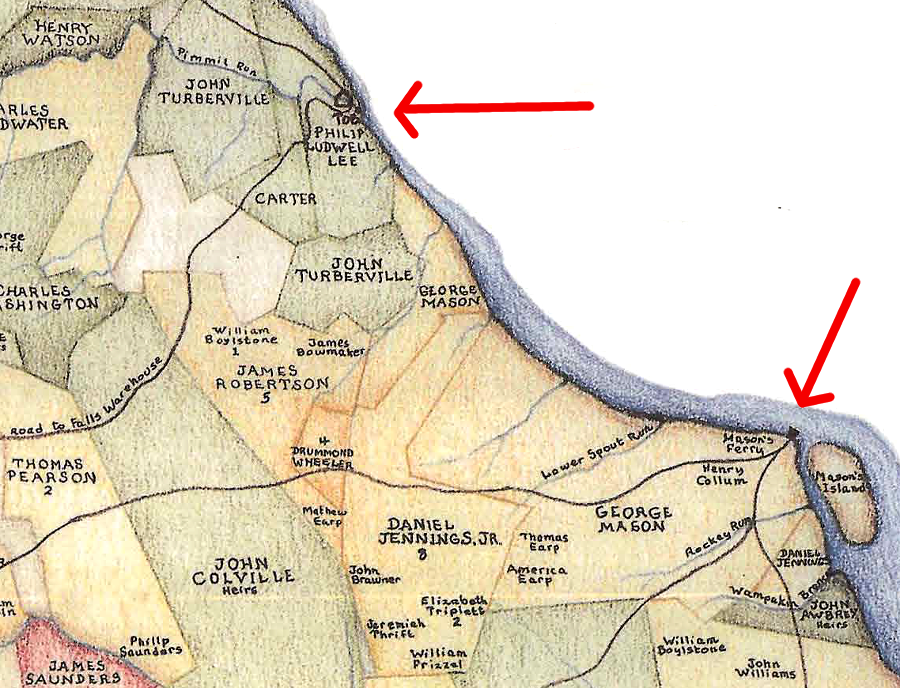
early in the 1700's, ferries crossed the Potomac River near Little Falls at Pimmit Run and Analostan Island
Source: Fairfax County, Interpretive Historical Map of Fairfax County Virginia in 1760 (created by Beth Mitchell, edited by Donald M Sweig, 1987)
Between 1732 and adoption of the 1785 Compact with Maryland acknowledging that state's control of the Potomac River to the mean low water line, the Virginia General Assembly approved almost 30 ferries on the Potomac River. Some were upstream of Great Falls. Nolands Ferry, downstream of Point of Rocks, was licensed in 1735. Swearingen's Ferry at Shepherdstown (now in West Virginia) was authorized in 1755.2
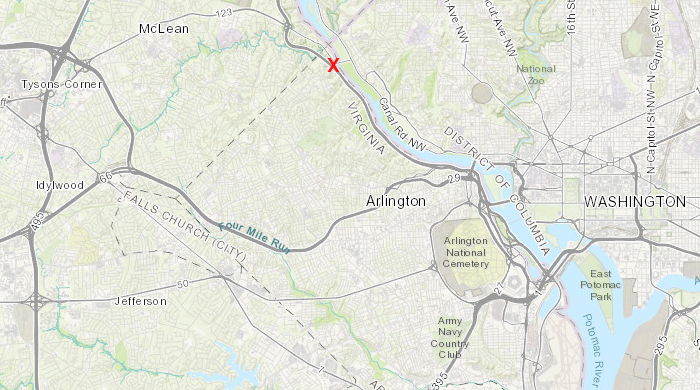
Thomas Lee started a ferry at Pimmit Run around 1720
Source: ESRI, ArcGIS Online
Ferries enabled people and cargo to cross the Potomac River even after the first bridge, Chain Bridge, was completed in 1797. Water-based travel on the Potomac River in Northern Virginia increased when the Federal government moved from Philadelphia to Washington, DC in 1800, since Long Bridge was not opened until 1809.
In 1813, commercial steamboats started carrying freight and passengers from Washington regularly, with connections to Marlboro, Norfolk, and Richmond.
There was even a ferry carrying Baltimore & Ohio Railroad freight cars from the Shepherd's Landing in the District of Columbia to Alexandria between 1874-1906. Construction of new bridges in the highway network, after adoption of the automobile, led to the replacement of nearly all ferries in Virginia prior to World War II.3
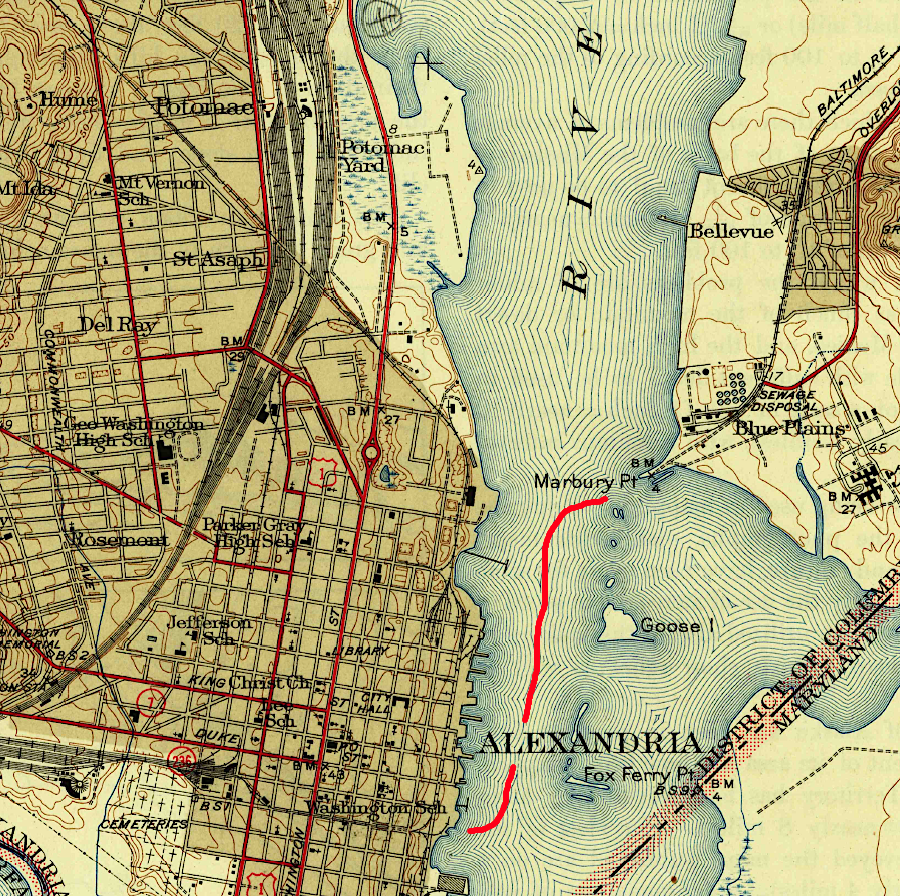
between 1874-1906, a railroad "car float" ferried railcars between Shepherd's Landing at Marbury Point and Alexandria
Source: US Geological Survey (USGS), Alexandria, VA 1:31.680 topographic quadrangle (1945)
In 1964, DC Transit proposed starting a new ferry on the Potomac River designed for commuters. The route would have linked Fort Washington, Maryland, roughly opposite Mount Vernon, to a terminal in the District of Columbia. DC Transit was still a privately-owned company, and the ferry was intended to increase the bus company's profits.
In 1988, the Metropolitan Washington Council of Governments (MWCOG) studied a ferry that would link Cherry Hill, Woodbridge, Indian Head, and Fort Washington with the Maine Avenue dock in the District of Columbia and the Pentagon in Virginia. Later studies have pushed the proposed length of the commuter ferry as far south as Quantico, reflecting the distance that sprawl development has extended.4
In 1999, Northern Virginia Congressmen Frank Wolf and Tom Davis obtained Federal funding for a study of high-speed passenger ferry service on the Potomac River. Some of the VDOT Ferry Boat Feasibility Study conclusions in 2000 were:5
Local officials in Prince William County have pursued a long-distance commuter ferry option despite the 2000 study's conclusions. Prince William completed a Potomac River Commuter Ferry Service Study & Route Proving Exercise in 2009, and brought an actual ferry south from Provincetown, Massachusetts to evaluate the time required to carry commuters from Prince William County to the Navy Yard.
The 2009 exercise revealed that commuter travel via ferry would be slower compared to other forms of transit. It re-affirmed that delays were caused by wake restrictions requiring slow speeds, especially upstream of Woodrow Wilson Bridge, and the shallow depth of the Occoquan River channel. Noise concerns were also identified as an environmental issue to mitigate.
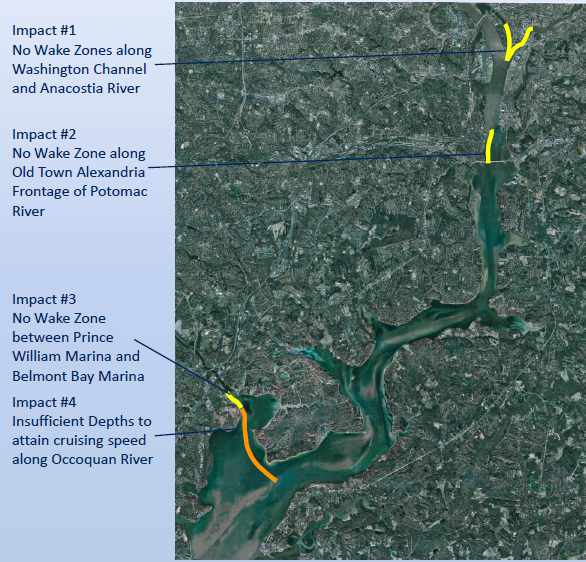
a 2009 study found that restrictions on wakes would slow ferry trips substantially at certain locations
Source: Metropolitan Washington Council of Governments, Prince William County Potomac River Commuter Ferry Study & Route Proving Exercise (Summary of Results, November 12, 2009)
Reflecting the hopes of the study sponsor, the report concluded:6

a 2009 study defined critical characteristics for a viable ferry service between Prince William County and the District of Columbia
Source: Prince William County, Prince William County Potomac River Commuter Ferry Study & Route Proving Exercise (Table 10-6)
The cost to implement short-distance water taxi operations on the Potomac River between National Harbor-Georgetown, using Alexandria as a hub, was just 10-20% of the $30 million cost to start a long-distance commuter ferry from Prince William County. The cost-effectiveness of expanding existing VRE services, rather than creating a new long-distance ferry, was not examined in the various studies.7
The Northern Virginia Regional Commission issued a 2013 study that declared daily water taxi service among Alexandria, Reagan National Airport, National Harbor and the District would be economically viable. Department of Homeland Security officials were interested in better access to their new headquarters in the former St. Elizabeth's hospital, located in Southeast DC.
In contrast, the US Army declared it would not be interested in a commuter ferry to Fort Belvoir. The costs to dredge the Potomac River channel and build a terminal were too high, considering the number of employees who would commute from Woodbridge.
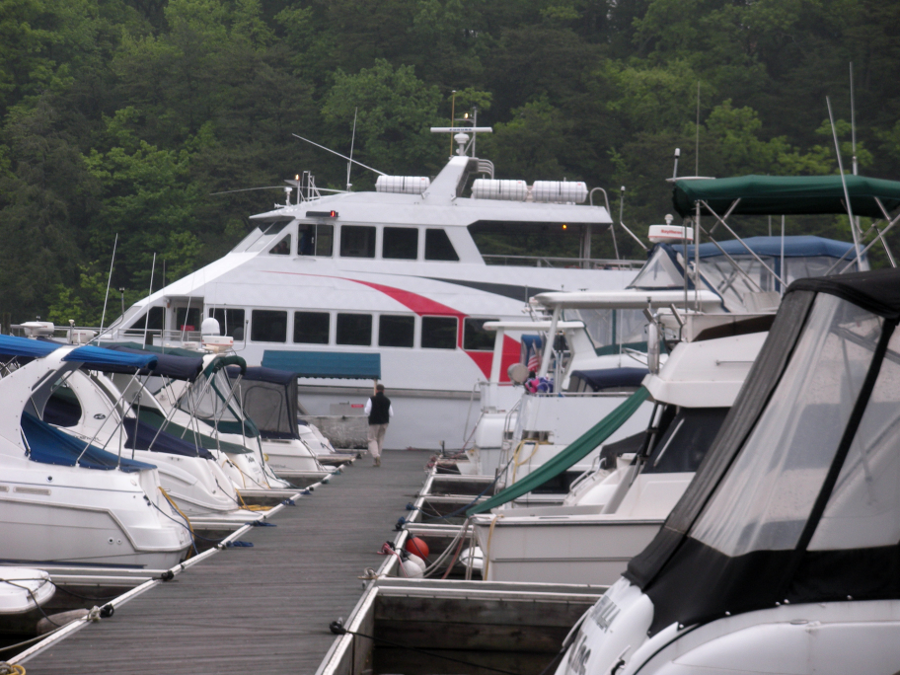
a 2009 study used an actual ferry to test the length of proposed commutes from Prince William to the Navy Yard in DC
In his comments on the results of the 2013 study, the director of transportation for the Metropolitan Washington Council of Governments made a clear distinction between the viability and priority of short-distance ferry routes between Alexandria, National Harbor, and the District vs. funding a long-distance commuter ferry that would parallel existing highway/transit capacity on I-95 and the Virginia Railway Express.8
In 2013, the supervisor for the Woodbridge Magisterial District in Prince William County proposed a Commuter Fast Ferry Project to the Virginia Department of Transportation (VDOT). The proposal for a public-private partnership included a three year demonstration project, using three 49-passenger vessels. They would carry passengers (not cars) between Woodbridge to the District of Columbia, and connect Alexandria to Joint Base Anacostia-Bolling across the river.
In 2014, VDOT decided not to consider the proposal further. The state agency decided that costs would be too high, and ridership too low, to alleviate gridlock.9
The VDOT decision did not dampen hopes in Prince William County for establishing a passenger ferry from Woodbridge to DC. The Northern Virginia Regional Commission got a positive response from the US Department of Transportation, when it created the M-495 Marine Highway Crossing in 2013. Marine Highways get preferential treatment for Federal grants, especially from the Maritime Administration.10
In 2014, the Marine Highway designation paid off. The Federal Transit Administration decided to provide nearly $3.4 million for a discretionary (not competitive) grant from Ferry Boat Program to initiate new ferry service on the Potomac River. The grant required a local match of $845,000.
News stories stated that the original $3.4 million grant would be used to purchase two boats and start a new commuter ferry from Jones Point Park in Alexandria to the Joint Base Anacostia-Bolling military installation in Southeast Washington, D.C. At one point, reduced availability of funding from Congress lowered the anticipated funding from the Federal Transit Administration to approximately $1.3 million. That would have required a $250,000 local match, for a total of $1.5 million to be available.11
The reduced amount would be enough to develop the proposed commuter ferry project in more detail, but inadequate to purchase any vessel(s) or to construct a ferry terminal on the designated Marine Highway. However, the Woodbridge supervisor was assured that the full amount would be provided when the county was ready to spend it, and in 2018 it appeared that would be the case.12
Ferry planning continued despite the absence of money to construct a terminal, buy a boat, and start actual operations. A 2015 market analysis by the Northern Virginia Regional Commission examined 26 possible terminal sites and 260 possible routes among them. That study eliminated half of the potential terminals, then evaluated remaining potential routes based on potential number of customers and their potential savings in travel time.
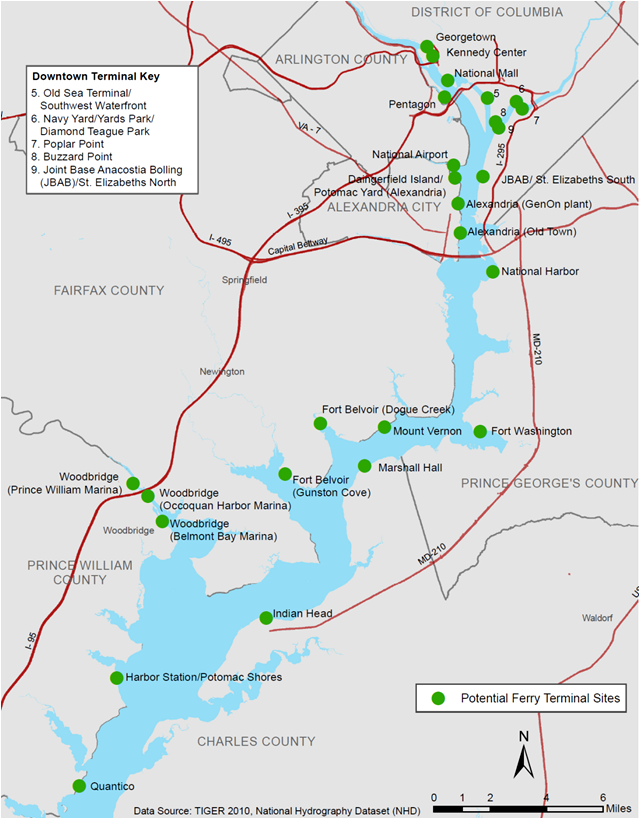
in 2015, the Northern Virginia Regional Commission explored 26 possible terminal sites for a commuter ferry on the Potomac River
Source: Northern Virginia Regional Commission, Market Analysis for Commuter Ferry Service on the Occoquan, Potomac, & Anacostia Rivers (June 3, 2015)
The 2015 market analysis assumed the use of small, 50-passenger ferries with no capacity for transporting cars. If trips operated every 15 minutes at peak hours and cost $8-$10 one-way, the study identified three potentially sustainable corridors that could each carry 1,100 to 2,000 passengers per day:13
The study did not identify as sustainable a longer-distance commuter corridor, with a ferry terminal at Woodbridge further downstream from Woodrow Wilson Bridge. However, the Maritime Administration provided a $174,000 grant in 2016 to the Northern Virginia Regional Commission to fund yet another long-distance commuter ferry study.
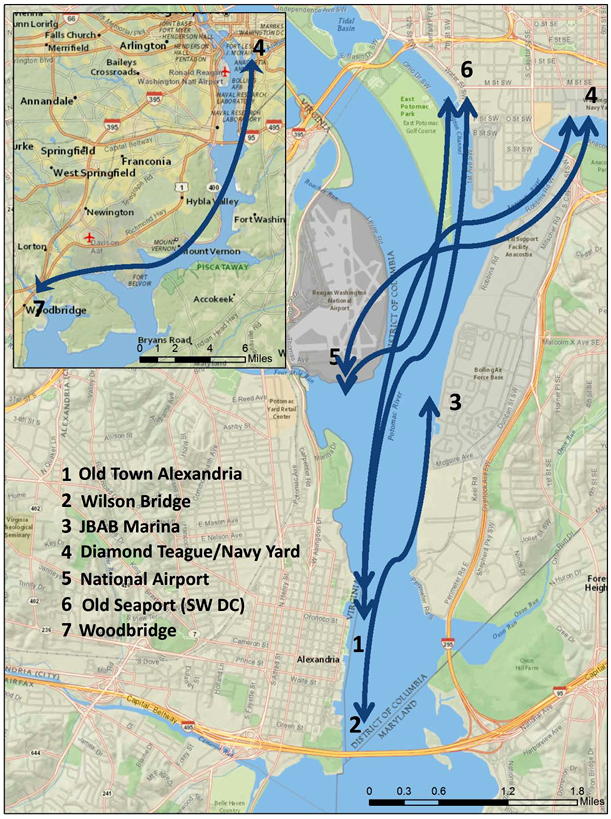
in 2015, the Northern Virginia Regional Commission considered possible ferry corridors on the Potomac River, and the longer-distance commuter corridor from Woodbridge was not defined as feasible
Source: Northern Virginia Regional Commission, Market Analysis for Commuter Ferry Service on the Occoquan, Potomac, & Anacostia Rivers (June 3, 2015)
Also in 2016, the private company that offered entertainment cruises between Alexandria, the National Mall, and the baseball park of the Washington Nationals team announced it was purchasing four 100-passenger ferries and planned to offer service in 2017 to commuters crossing the river. Based on the analyses done previously, Potomac Riverboat Company calculated it could make a profit by offering an alternative to short-but-frustratingly-slow drives between Alexandria, Maryland, and DC.
The new Regional Water Taxi System was designed for regular commuters to use the Potomac River as a highway between docks in Alexandria, Georgetown, the Wharf in Southwest DC, and National Harbor. The private company anticipated future expansion to service Reagan National Airport as well.
The investment was well-timed. In 2019 Metrorail closed the six Blue and Yellow line stations south of Ronald Reagan National Airport from May 25-September 8 for station platform repair. Potomac Riverboat Company offered additional service between Old Town Alexandria and the Wharf in Washington, DC, while a grant from the Virginia Department of Rail and Public Transportation reimbursed commuters for 80% of their cost for a ticket. The service attracted 5,000 passengers daily before the Metrorail stations reopened, and Potomac Riverboat Company continued to offer it as a continuing alternative to the train.14
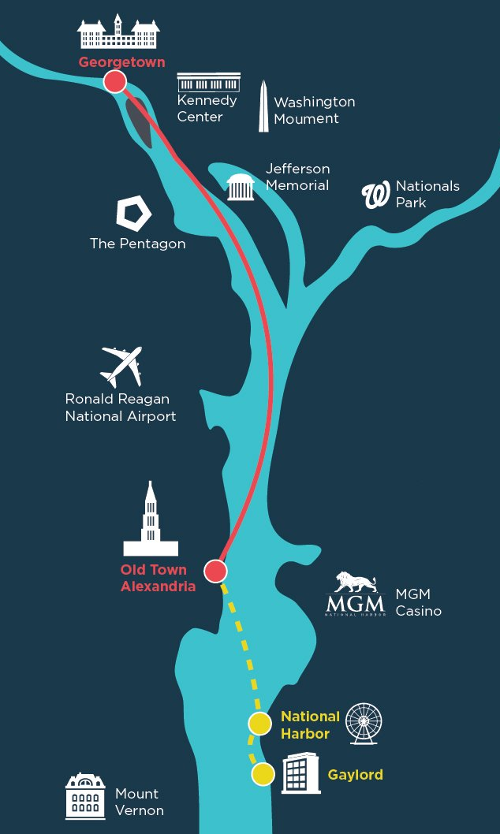
the Potomac Riverboat Company water taxi linked Georgetown, Alexandria, and Gaylord/National Harbor in 2017, before The Wharf in DC opened
Source: Potomac Riverboat Company
Using the funding from the 2016 grant by the Maritime Administration, the Prince William County supervisor who has consistently championed a commuter ferry organized another demonstration of ferry travel in 2017. A passenger ferry made two trips from near Belmont Bay, which was identified as the likely site for any terminal because it avoided most of the no-wake zone on the Occoquan River.
After the demonstration runs, public presentations revealed that planning was focused using three passenger ferries, each capable of carrying 300-400 passengers. They would each run one trip in morning rush hour and one trip in the evening, so together they could transport 900-1,200 commuters each day.
Each ferry would cost $10 million, and costs to build new shore-side infrastructure for a terminal might add an additional $5 million. The head of the private company operating water taxis stated that after seven years of discussion with the Belmont Bay developers, they had still not negotiated a lease for a terminal there.
A trip to National Harbor or the Navy Yard at 48 knots was expected to require around 45 minutes, and cost $30 round-trip. Funding would be negotiated in a public-private partnership, with Prince William County seeking grants from the Federal Transit Administration and the Department of Transportation for the shore-side infrastructure.15
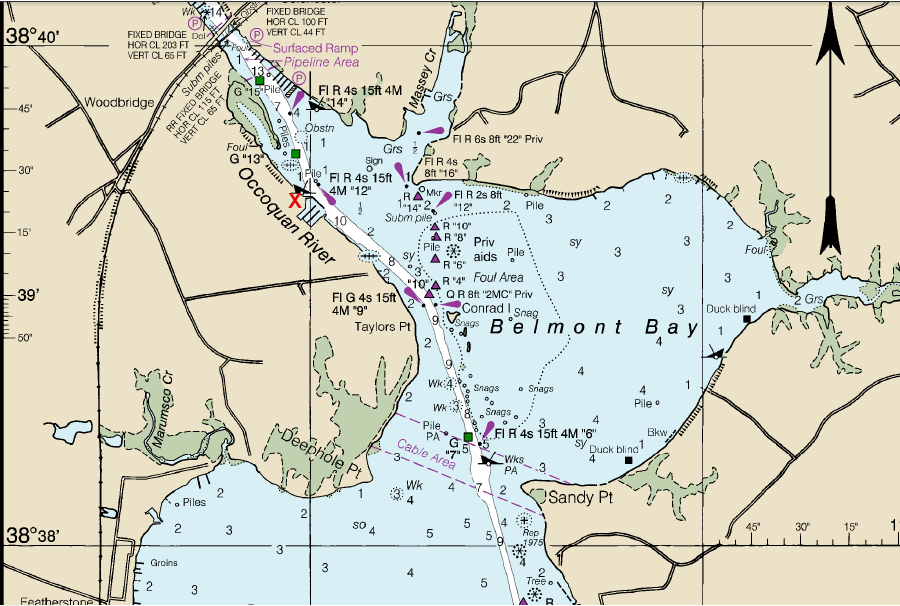
a ferry landing on the Occoquan River (red X) would require passing through Belmont Bay before reaching the main channel of the Potomac River
Source: National Oceanic and Atmospheric Administration, Nautical Chart 12285 (Potomac River)
The Northern Virginia Regional Commission funded an "infrastructure gap" study in 2018. By that time, the expanding population in the suburbs was matched with redevelopment on the waterfront in the District of Columbia, including the Wharf and a new soccer stadium at Buzzards Point. The demand for transit services to destinations on the waterfront would steadily increase, but the study identified that 70% of the commuter ferry market from Woodbridge area was interested in going to Joint Base Anacostia-Bolling or the offices of Homeland Security at St. Elizabeths.16
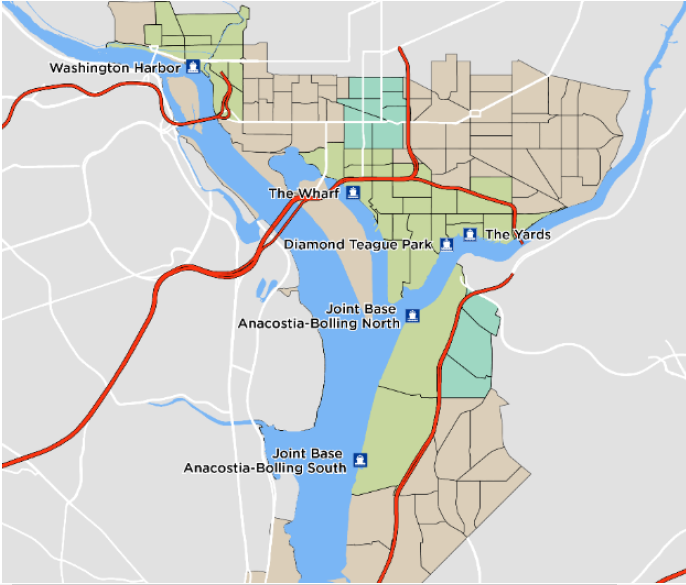
most potential users of the proposed commuter ferry were interested in getting to Traffic Analysis Zones (TAZ's) close to Joint Base Anacostia-Bolling
Source: Northern Virginia Regional Commission, Infrastructure Gap Analysis Study - Public Presentation (Slide 10, June 4, 2018)
Frank Principi, the supervisor for the Woodbridge District in Prince William County and champion of the proposal, described the Potomac River as "the last unused highway in the region." The congested highways were an obvious problem, even after expansion of the High Occupancy Toll (HOT) Lanes on I-95, but he justified the investment in a fast ferry in part by saying:17
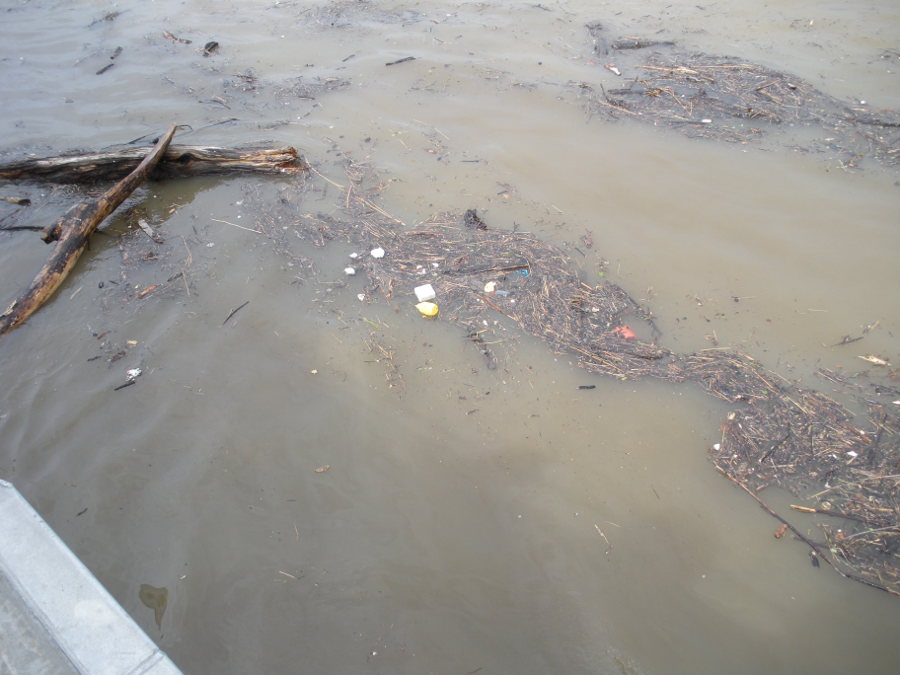
the 2009 test with an actual ferry revealed that debris in the water after rainstorms could force the ferry to reduce speed dramatically
Supervisor Frank Principi described the proposed ferry as "an additional transit service." He suggested VRE was already overcrowded, so the Potomac River was the next logical way to move commuters into the District.
In 2018, the Potomac and Rappahannock Transportation agreed to administer the grant that had been awarded by the Federal Transit Administration in 2014. Initial plans were to start ferry service with two 400-passenger boats, traveling at roughly 50mph between the Occoquan Harbour Marina in Prince William County and Joint Base Anacostia-Bolling (JBAB) in DC.
The pool of initial customers was limited, because the Department of Homeland Security insisted that only people with security clearances could get off the ferry at the base. There were an estimated 6,000 people with clearances living within 15 minutes of the Occoquan Harbour Marina, and ferry advocates anticipated they could recruit enough to make the project cost-effective. If the ferry route was extended to transport passengers to National Harbor or a second location in DC, then the pool of potential customers would expand even further.
Local and regional agencies would not be required to provide the $845,000 funding match. Instead, the land used for the boat dock and parking area would be provided without cost for five years, and rent-free use of land for shore-side infrastructure was valued at $950,000.
The county supervisor who had championed the project was defeated in a primary contest in 2019, but he still anticipated the ferry starting service in 2021. Though initial service was planned to connect Occoquan with Joint Base Anacostia-Bolling (JBAB) and the new Homeland Security campus in DC, he continued to imagine expanding to Ronald Reagan National Airport, Amazon's headquarters in Crystal City, and the Wharf.18
The Potomac and Rappahannock Transportation Commission (PRTC) issued a Request for Information for the M-495 Commuter Fast Ferry Operations in late 2019, in order to gauge private sector interest in operating a fast ferry on the "National Capital Region's underutilized 'blue' highway." The focus was on identifying a private sector partner who would make their profit from just farebox revenues, without a direct government subsidy. However, initial infrastructure costs, including the ferry boats, would range between $75-$100 million.
Market research noted in the Request for Information stated that the origin-destination pair between Occoquan Harbour Marina (North Woodbridge) and Joint Base Anacostia-Bolling (JBAB) had:19
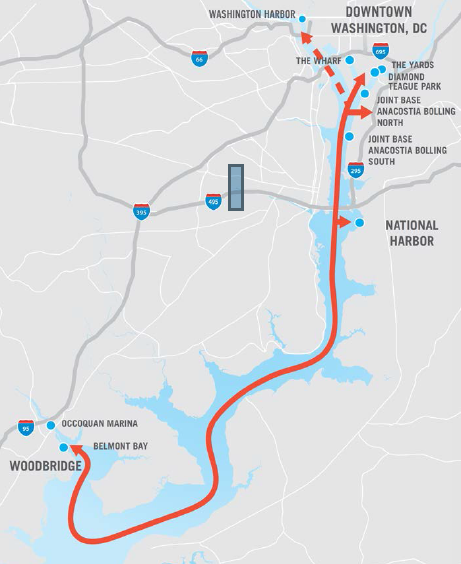
the proposed commuter ferry would connect Woodbridge to Joint Base Anacostia-Bolling and potentially Potomac Yards
Source: Northern Virginia Regional Commission, Infrastructure Gap Analysis Study - Public Presentation (Slide 3, June 4, 2018)
In 2020, the District of Columbia Council Chair notified the M-495 Regional Commuter Fast Ferry Stakeholder Group that the District was committing $500,000 to complete the business case for the fast ferry.20
The stimulus for an elected official in Prince William to continue studies of a long-distance commuter ferry is obvious. Commuters are voters, and voters stuck in traffic want solutions. Politicians benefit from proposing new solutions to long-standing traffic congestion problems. Even if studies continue to question the cost/benefit ratio of a new solution, proposing a ferry makes an incumbent or a candidate appear to be a person who can solve the traffic congestion problem.
A commuter ferry from the periphery of the DC urban region would solve only the "how to get to work" problem. Ferries would operate as one-way transportation services, carrying commuters in the morning into DC and bringing them back to the suburbs in the afternoon.
The proposed ferry offered virtually no opportunity to stimulate development of transit-friendly communities in Prince William. Facilitating the export of workers to DC would not help to convert that county from a bedroom community into a job center. The Potomac and Rappahannock Transportation Commission (PRTC) transit officials are in the transportation business, not in the land use planning business. They have focused on transporting people and improving service for commuters, rather than stimulating transit-oriented development that would reduce overall transportation demand.
The primary alternative to using I-95 is the Virginia Railway Express (VRE). The railroad trip from Woodbridge to L'Enfant Station would take the same amount of time as a ferry trip to the Navy Yard. Ferry operators needed $15/trip to make a profit, so transit subsidies would be needed to compete with the VRE cost of $10/trip.
People living within walking distance of the Belmont Bay terminal (and thus the Woodbridge VRE station) were the most likely candidates to choose the ferry. Previous studies had shown that people who had already driven part-way to work on I-95 were less likely to switch modes and take a ferry to complete their commute to work.21
Greater investment in the VRE offers the potential of converting that commuter rail system into a two-way transit system, with trains running regularly throughout the day as well as at rush hour. With more trains running more often, higher-density development at train stations - as envisioned at the Belmont Station community near Occoquan - could become a reality, rather than stay a long-range vision in planning documents.
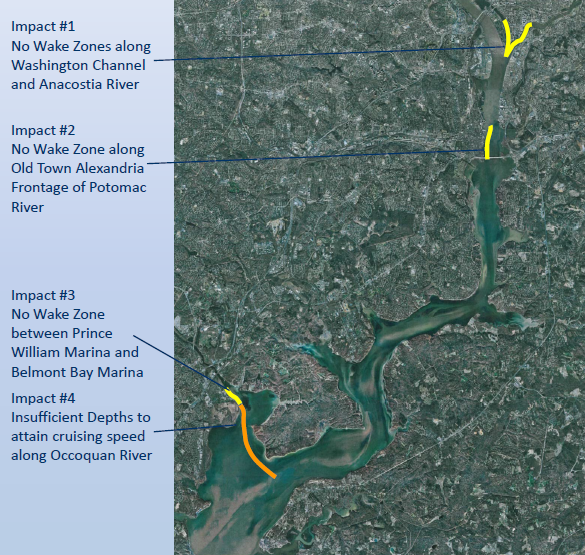
commuting via a long-distance commuter ferry from Prince William County to the Washington Navy Yard would require more time than trips in a car, CommuteRide bus, or Virginia Railway Express (VRE) commuter train due to speed restrictions from shallow channels and no-wake zones
Source: Metropolitan Washington Council of Governments (MWCOG), Prince William County Potomac River Commuter Ferry Study & Route Proving Exercise (November 12, 2009)
Creating walkable communities, with retail/restaurant operations next to train stations comparable to the Rosslyn-Ballston corridor, recognize that it takes decades to stimulate such redevelopment. So long as Virginia Railway Express trains run only one-way during rush hours, the lack of service during the middle of the day and the evening will limit developer interest.
There is no guarantee that increased VRE service would transform Belmont Bay into a neighborhood comparable to Clarendon or Ballston, but offering a peak-hour only commuter route via a ferry is even less likely to stimulate Transit Oriented Development in Prince William County.
Subsidizing extra trains would require substantial funding for years, until the benefits of redevelopment led to increased tax revenues that were directed to the transit service. The potential for using Virginia Railway Express to stimulate transit-oriented development is higher on the Fredericksburg line than on the Manassas Line. There are more conflicts with freight rail use on the Fredericksburg line, but more sites suitable for Transit Oriented Development and thus for generating new customers for train rides. Fairfax County has not planned for dense growth around the VRE station at Burke Center.
On the Fredericksburg Line between DC-Spotsylvania County, there are already more residents and the demand for mid-day trains is greater. In addition, additional Virginia Railway Express services throughout the day could be supplemented by the planned expansion of Amtrak services between Richmond-DC.
The SmartScale ranking process for projects considered by the Virginia Department of Transportation is tilted towards projects that reduce congestion quickly. Even if the ranking factors never increase the weighting factors for long-term benefits of land use transformation, the analyses of proposed transportation projects in Northern Virginia are likely to favor investment in Virginia Railway Express upgrades over creation of a new commuter ferry system.
The supervisor who championed the Fast Ferry was defeated in a primary election in 2019. The new supervisor also supported inclusion of a primary and alternate ferry dock on the Occoquan River in a "small area plan" for shaping development at North Woodbridge. In addition, she discussed the potential for developing a tourism-oriented service rather than a ferry for commuters.22
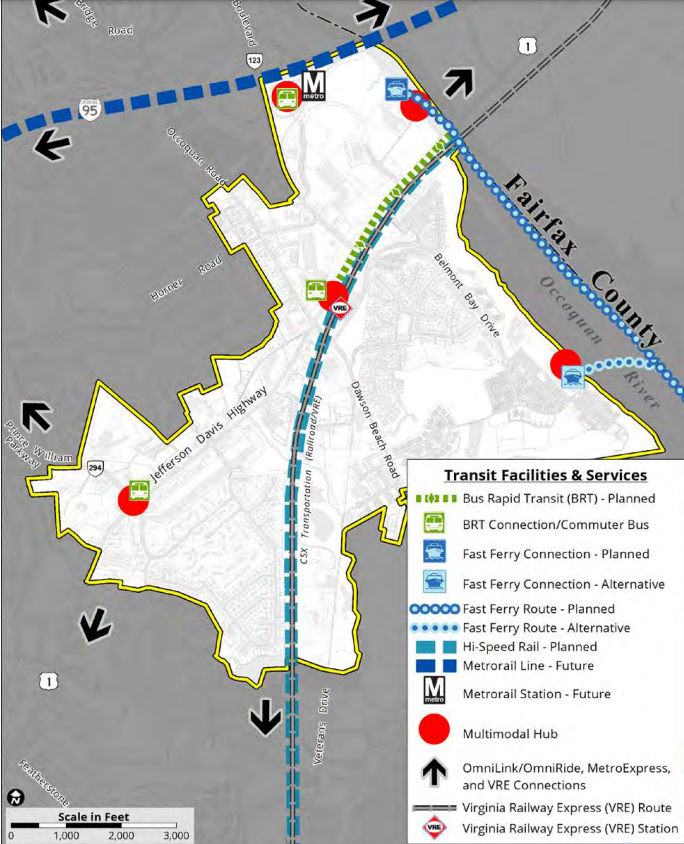
two possible ferry dock locations on the Occoquan River were identified in the North Woodbridge Small Area Plan
Source: Prince William County, North Woodbridge Small Area Plan (Figure 58)
In 2022, the Northern Virginia Regional Commission conducted yet another study to create a business case for the fast ferry. When initiated, the executive director of the commission commented:23
The 2022 study was commissioned when the COVID-19 pandemic had dramatically reduced commuter ridership on OmniRide, Virginia Railway Express, and the Metrorail system around Washington, DC. The executive director of OmniRide justified the study under those conditions:24
That study, completed a year later, examined 19 possible routes. It found four to be feasible, one originating in Woodbridge would go to Joint Base Anacostia-Bolling and one route between Charles Count to Joint Base Anacostia-Bolling. Other feasible alternatives were a ferry going between Woodbridge and the Southeast and Southwest Waterfront in Washington, DC, and a "DC River Circulator" connecting Georgetown-Poplar Point.
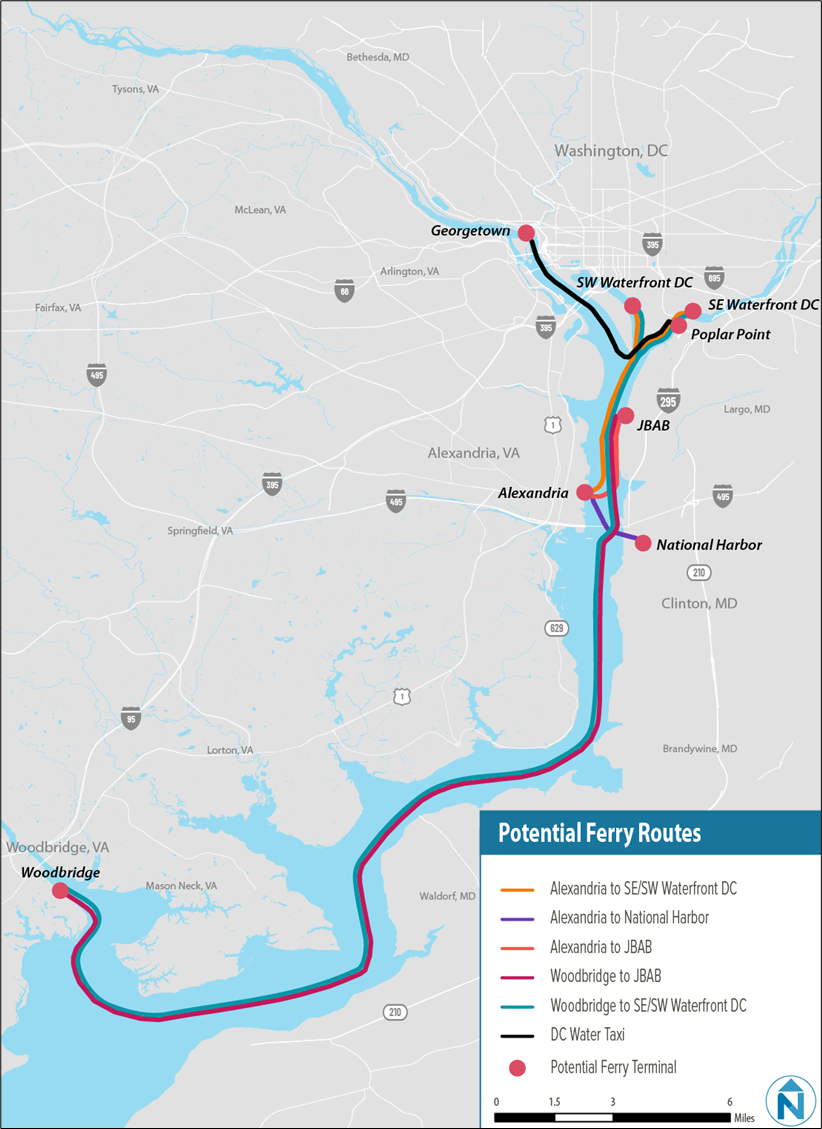
19 possible options for different ferry routes were considered in 2023
Source: Northen Virginia Regional Commission (NVRC), M495 - Fast Ferry Passenger Service Business Plan Final Presentation (September 28, 2023)
The Woodbridge-Joint Base Anacostia-Bolling route would serve 85 to 839 daily riders. Capital costs to prepare landing sites and acquire ferry boats were estimated at $23-$53 million. Annual operating costs were projected to be $11 million, or $25/trip if that ferry route was designed to service commuters rather than tourists.
Fare prices were projected to be set below actual costs for each trip. As on other Northern Virginia bus and transit rail systems, farebox recovery would be less than 100% and an annual subsidy would be required. There was no potential for a private ferry operator to offer service on the proposed routes as a for-profit business.
All the alternatives examined would require public funding for both the initial capital costs and the annual operations. A ferry subsidy would compete with funding requests from other transit services in the region. When the 2023 study was released, the General Assembly was no longer expecting to be allocating budget surpluses; Metrorail was facing a $750 million shortfall and talking about shutting down service to existing stations.
Under those circumstances, no one on the Northern Virginia Regional Commission championed moving forward on the ferry proposal in 2023.
In the report to the commission, the consultants asked "What happens to this project?" The bullet points on the slide offered:25

all ferry options required a public subsidy for operations; no alternatives would be self-supporting
Source: Northern Virginia Regional Commission (NVRC), M495 - Fast Ferry Passenger Service Business Plan Final Presentation (September 28, 2023)
In 2024, the proposed move of the Washington Wizards and Capitals to a new arena at Potomac Yard generated new interest in water taxi service between Washington DC and Northern Virginia. The Chief Executive Officer of the Alexandria Economic Development Partnership suggested a water taxi up Four Mile Run could be part of the transportation plan to handle the new demand.
Minimal new parking was proposed for the new $2 billion entertainment district in order to minimize new traffic congestion, and the new Potomac Yard Metrorail station was inadequate to accommodate the surge of visitors anticipated for major-league sports events. The mayor of Alexandria sought to reassure residents after the proposal was announced on December 13 2023:26
The feasibility of water taxi access to the arena proposed by Monumental Sports & Entertainment was questionable:27
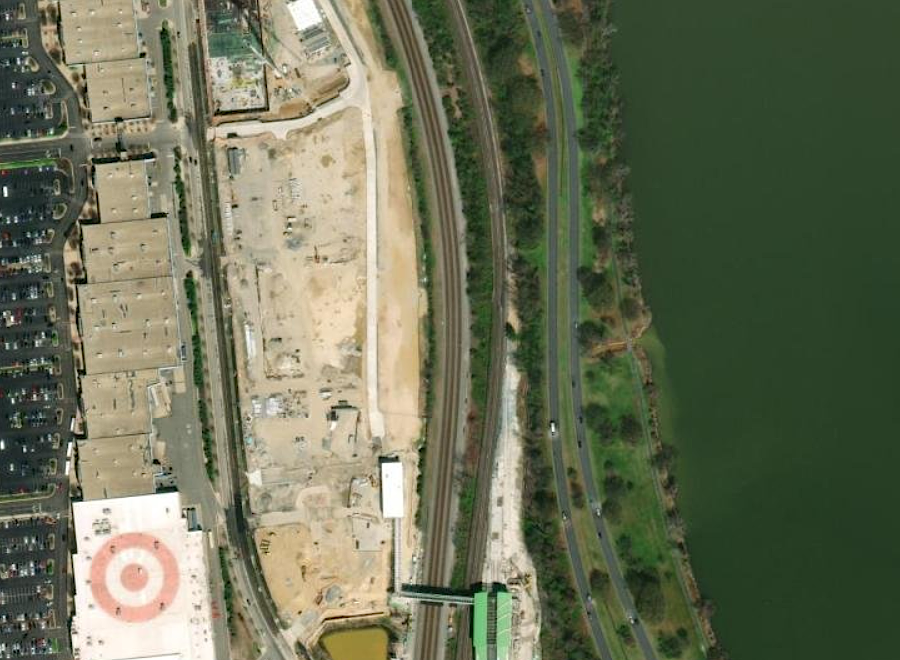
water ferry access to the proposed sports arena at Potomac Yard would require people to cross the George Washington Memorial Parkway and CSX tracks
Source: ESRI, ArcGIS Online
A 2025 proposal for commuter ferry service from Georgetown to Ronald Reagan-Washington National Airport was based on the development of hydrofoil boats powered by electricity. By lifting the boat out of the water, the energy required to move was minimized. No wake was generated, reducing impacts on other boaters as well as costs.
A spokesman for the Swedish company that manufactured the hydrofoils claimed the new technology addressed the reasons why commuter ferries had not been successful on the Potomac River despite the congested highways:28
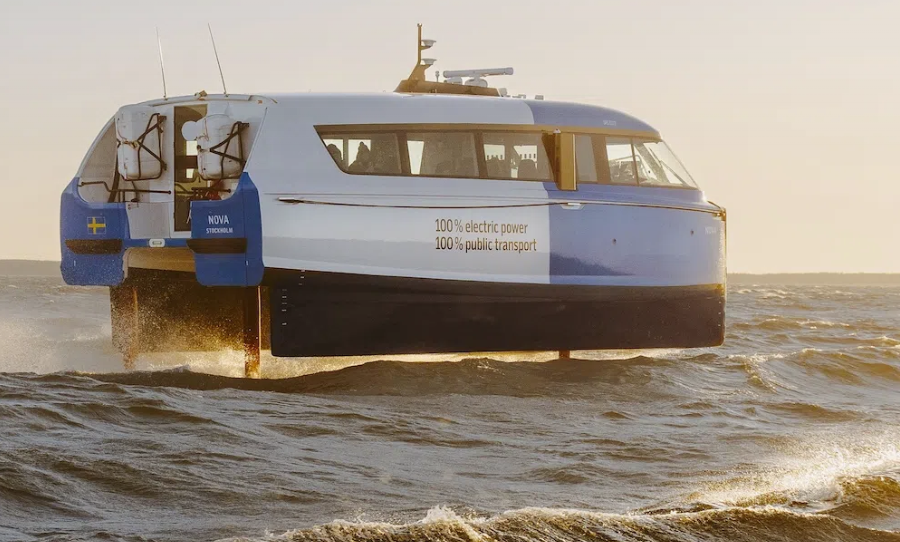
in 2025 Candela, a Swedish company, proposed using electric hydrofoils as commuter ferries on the Potomac River
Source: Candela